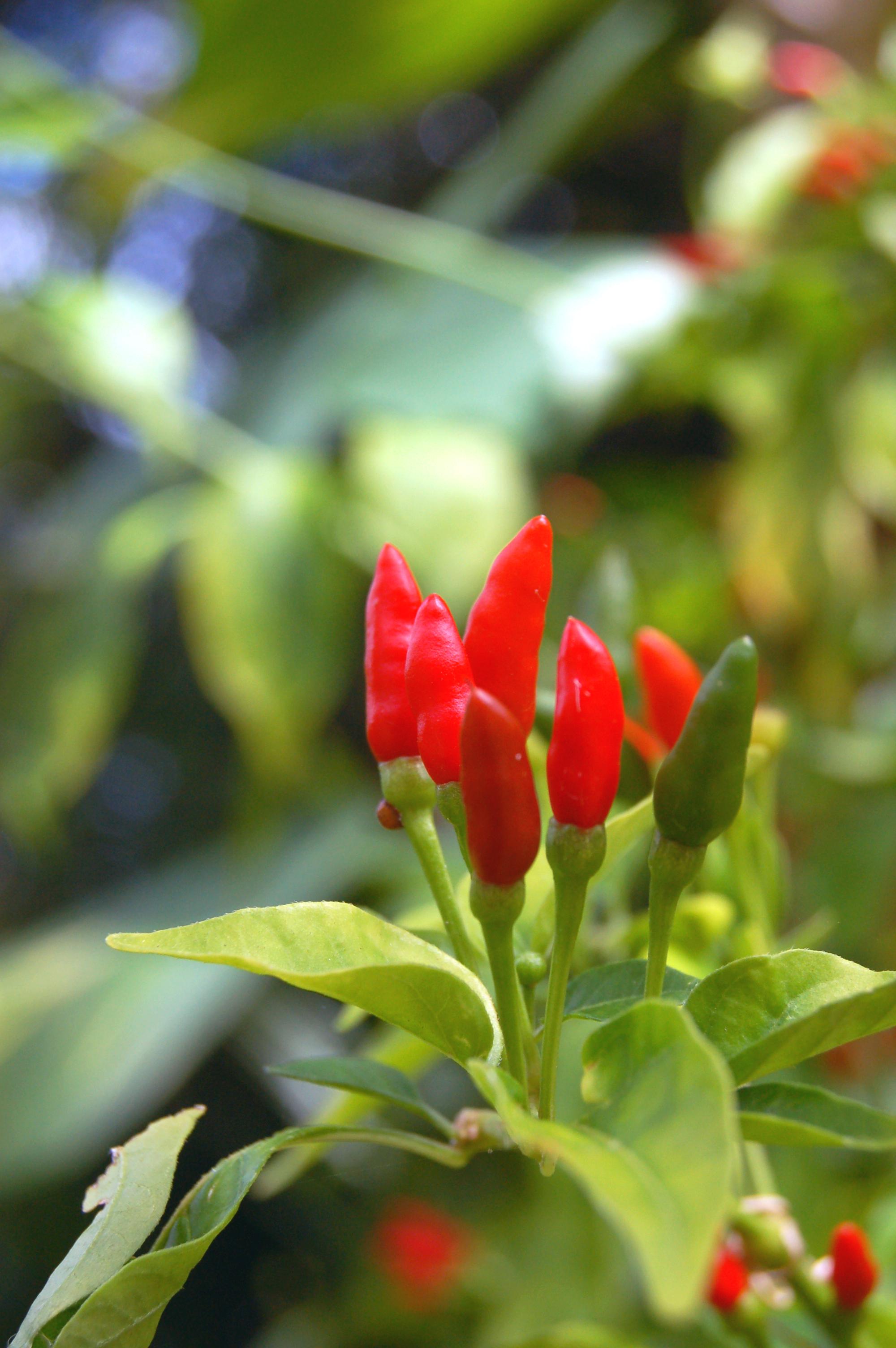 The secondary focus of my research is the comparative metabolomics of the Solanaceae (i.e. I'm seeing what kinds of chemicals are present in different fruits in the nightshade family).
The secondary focus of my research is the comparative metabolomics of the Solanaceae (i.e. I'm seeing what kinds of chemicals are present in different fruits in the nightshade family).Our 2009 Upstate summer was waaay too cool and short for a number of our more tropical species and landraces* so I dug up and moved a dozen or so of them to the greenhouse to finish up. Our Latin/South-American chilies are finally about done.
I'm especially intrigued by our accession of Capsicum eximium, which is, as far as I know, a completely wild, undomesticated pepper. I would figure that it wouldn't be particularly hot or flavorful since these are among the first traits that humans improve when they start saving seed.
In the wild, peppers "want" to be eaten by birds (which digest the fruit without hurting the seeds) over mammals (which tend to chew the seeds to death) so they produce capsaicinoids, super spicy chemicals that only mammals can taste!
A recent PNAS study found that spicy subpopulations of a wild chili were attacked less by insects and a pathogenic fungus than less spicy subpopulations. Although this would suggest that peppers can protect their seeds from fungi and animals by being hot, the authors' previous study also found that plants that produced lots of capsaicinoids tended to have thinner seed coats - which are more vulnerable to animal digestion. The authors suggest that these selective pressures favor a population with mixed levels of spice. I would imagine that when peppers are routinely spicy, mammals would learn not to eat them, allowing some individuals to enjoy the benefits of thick seed coats (better germination after bird consumption) without suffering losses to mammalian herbivory (due to low spice).
As I collected the tiny, glossy red C. eximium fruit, I remarked to my co-worker that they looked like little candies. (Ironically, our yellow-fruited Peruvian aji variety is actually named "dulce.")
"Should I try one?"My coworker laughed at me for the suggestion. I popped one into my mouth: a thin, shriveled little fruit less than half an inch long.
"It's like chewing on a piece of bark... there's no flavor at all....I spat out the pepper and laughed as the spice burned across my tongue, which eventually went a little numb. I looked around, regretting I was away from my desk.
oh wait! it's really flavorful!.. and a little hot!
it's pretty hot. hmm, it's getting hotter. uh, it might be really hot...
uh oh....."
"Is this [greenhouse spigot] water "industrial" or can I drink it??"It wasn't the hottest pepper I've ever eaten: that was one I mistook for a snow pea pod that left me flushed, out of breath and (for more than an hour) with a burnt throat.**
It was incredible though that a pepper as small as C. eximium's could be that HOT! I never would have guessed. I would need many dozens of them to equal the weight of a habanero or jalapeno (which aren't big peppers to begin with) It was really good too! Very flavorful. Would be great for chili.
* I have to plug Johnny's Seeds here. This "employee-owned" seed company operates out of Maine and produces appropriately cold-adapted varieties. We had tremendous yields out of multiple varieties of pepper and eggplant (which are notoriously cold-intolerant) in spite of our unusually cold and short, Northern summer. Our wild and heirloom varieties (that we got elsewhere) were a complete failure as of September.
** I feel that I should put this in the perspective that I love spicy food more than almost anyone I know. My mom never cooked spicy food when I was a kid, but I was known in my family for eating salads that were "gray" with black pepper and I want any restaurant cook who's cooking my Mexican or SE Asian food to feel personally challenged that they can't make it too spicy.

That sounds awesome! Wish I had a secondary research focus that involved growing really spicy peppers. When I was in Ithaca there were only two Indian restaurants, and Sangams (sp?) would never make food all THAT spicy. Thai food on the other hand...
ReplyDeletehaha, well I've heard people refer differently to foods that are "hot" and "thai hot"
ReplyDeleteHaving suffered a particularly poor summer (again), I'd be interested to know which peppers did well for you. Outdoor eggplants you can forget in our maritime climate here in western UK.
ReplyDeleteRhizowen, I havent heard of that book but I'll check it out.
ReplyDeleteWe had decent luck with our eggplants this past summer too (all the seeds were from a seed company in Maine (Johnny's), which has even worse summers than us).
Johnny's 226 (baby) and Kermit (thai) eggplant, Anaheim Numex, Tiburon Ancho, Hot Lantern.
Could you tell me what kind of pepper that is that you're talking about in this article? I ate a pepper in the Philippines that sounds exactly like the one you ate and it was just as small too with both red and green ones.
ReplyDeleteHi Carenna,
ReplyDeleteIt's some unknown domesticated C. frutescens. From what I've heard, this species was domesticated into two main types - small, pungent peppers, and big, non-pungent ones. I think all peppers turn start green and turn red/orange/yellow if you allow them to ripen completely. I don't know any more detail than that unfortunately, but there may be some info on the web of what varieties are popular there.
Good luck!